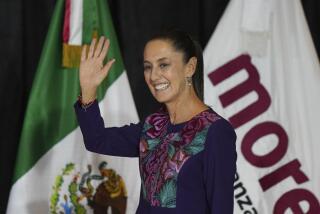Vote Wasn’t Bought, Sandinistas Blew It : Nicaragua: American liberals did a disservice to Nicaraguans, who, given the chance, proved to be astute analysts of where their revolution went wrong.
- Share via
The Sandinistas’ decisive defeat at the polls ought to have Americans, especially academics, reexamining their assumptions about the Nicaraguan conflict. Was U.S. policy really at the root of it? Or did the Sandinistas alienate their own people?
Many academics who cut their teeth on the anti-Vietnam War movement believe something like this: The big, ugly U.S. bullied little Nicaragua until it finally cried uncle. The Sandinistas got in trouble only because they wanted to be independent and Ronald Reagan wouldn’t permit it. The Reagan-Bush CIA funded remnants of the ex-dictator Somoza’s National Guard, placed an embargo on the Nicaraguan economy and then bought the election.
But this U.S.-centered view ignores some stubborn facts.
The Carter Administration granted the Sandinista regime the largest U.S. aid package in Nicaraguan history--$124 million. For 18 months that Administration pursued single-mindedly its friendly policy toward the Sandinistas. It encouraged other countries to provide aid, international lending organizations to give big loans, and private banks to reschedule the Nicaraguan debt on exceedingly favorable terms. Nicaragua’s revolutionary regime received more than $3 billion in Western aid in its first three years.
Nonetheless, by 1982 the Nicaraguan economy was in crisis. Real wages had fallen 70%. Peasants were refusing to sell their crops to the state and many had turned to producing only for their own families. The bottom had dropped out of Nicaraguan exports. Without foreign exchange, spare parts couldn’t be bought abroad and factories started to close. Shortages appeared everywhere. The countryside especially was in turmoil.
The economic crisis was part of the reason why the Contras grew like Topsy after 1982. They became the biggest rebel army in Latin America, three times the size of the Salvadoran guerrillas in a country with half the population.
The 1985 U.S. embargo was placed on a bankrupt economy by a Reagan Administration anxious to placate the right wing after losing a Contra aid vote. The embargo hurt the already crippled private sector far more than the Sandinistas. It was only when the U.S. invasion shut down the Sandinistas’ many dummy corporations in Noriega’s Panama--set up to evade the U.S. sanctions--that the embargo began to look like a real problem for them.
Probably less than 10% of the $9 million that Congress appropriated for the Nicaraguan election process got to the opposition. Part was raked off by the government to “administer” the election, and much of the rest went to pay for international observers and poll watchers or was tied up in Sandinista red tape. The day after the election, international observers saw photocopying machines and telephones arriving at opposition headquarters after having been detained for months at customs.
It was the Sandinistas who were flush, not the opposition. Their lavish campaign made liberal use of government funds, offices, telephones, vehicles and so on. The Sandinistas virtually monopolized radio and television election programming.
It was not the United States that defeated the Sandinistas but the Nicaraguan people. Starting in 1979 the Sandinistas had attacked and sought to dismember every independent institution of Nicaraguan civil society: labor unions, the press, the church, the family, the private sector, political parties, professional organizations, the non-Latino small farmers (whom they called “kulaks”) and the Indian communities of the Atlantic coast. The Sandinistas became the enemy of the people.
Before the November, 1984, election, there appeared to be the beginning of the same kind of political chain reaction--one rally building on another as people conquer their fear--that elected Violeta Chamorro last Sunday. But the government erected obstacles that certain opposition politicians considered too great to overcome. These recalcitrants, apparently encouraged by the CIA, created delays that handed the Sandinistas a pretext for barring them from the election. Had the opposition run, had the Sandinistas let it run, many young Nicaraguans’ futures might have been spared.
The Sandinistas lost last Sunday not because of the United States but because Nicaraguans got their first real chance to vote them out of office. They lost because they gave Nicaragua a decade of totalitarianism rather than the democratic revolution they promised.
Nearly every American pollster, pundit, news organization and professor of Latin American studies was sure the Sandinistas would win handily. These experts assumed that Nicaragua was as transparent as Iowa. In American elections, the candidate with the most money and the best organization usually wins. But no amount of money could compensate Nicaraguans for the wreckage of their culture and society.
Especially curious about the experts’ ethnocentric confusion of Nicaragua and Iowa was that it came from the very people who have been telling us how irrelevant “American-style democracy” is in places like Nicaragua. The bien pensant professors who told us that Nicaraguans blamed the United States for their economic crisis, that Nicaraguans considered the opposition an imperialist proxy, and so forth, will now strive to explain how the opposition tricked 55% of the voters. Will they tell us that the Nicaraguan campesinos who walked for miles to register and vote away from their own villages where they feared reprisal, that the nation that lined up at dawn and waited in line for hours to vote, were actually capitulating to imperialism?
Those truly opposed to imperialism could start by doing Nicaragua the honor of understanding it on its own terms. Nicaragua never was the Vietnam of the professors.
More to Read
Sign up for Essential California
The most important California stories and recommendations in your inbox every morning.
You may occasionally receive promotional content from the Los Angeles Times.













